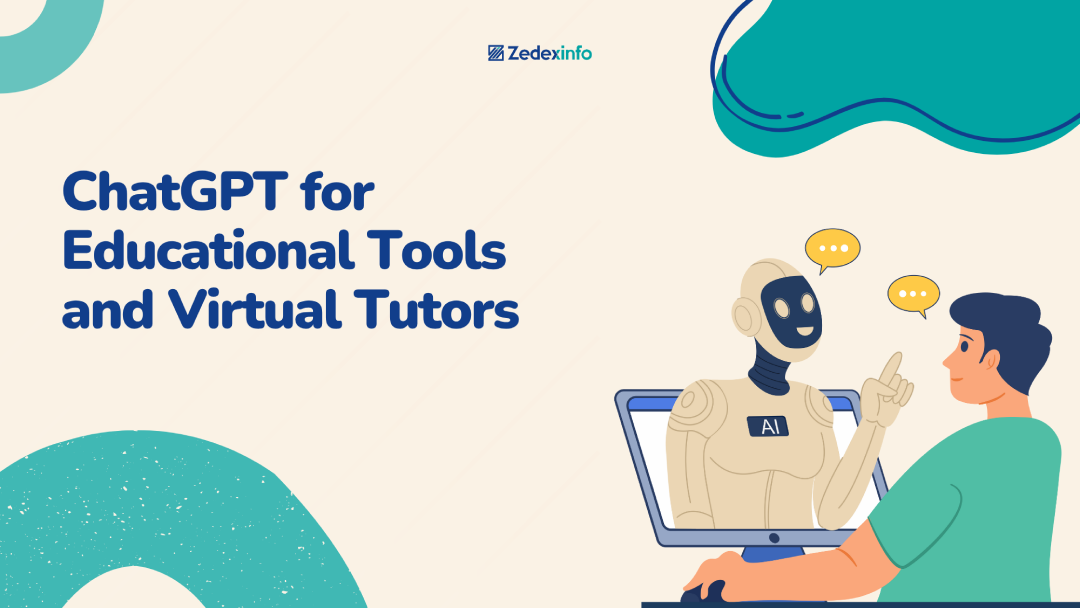Artificial intelligence has been making waves in various industries for quite a while now, and education is no exception. Teachers, administrators, and learners are constantly on the lookout for new ways to enrich the learning experience. Over the years, platforms that incorporate AI have emerged to help students learn more effectively. These tools are changing how content is delivered and are also transforming the very essence of classroom interactions.
Among such latest breakthroughs, ChatGPT is a language model that has grabbed headlines and sparked a lot of excitement. Many educators are now considering how ChatGPT can benefit their teaching goals, while parents are curious about whether it can support their children’s studies. Students themselves are eager to see if it can help them understand tough subjects, solve problems, and even polish their writing.
In this article, we will explore how ChatGPT can be used in educational contexts. We will consider the benefits, the challenges, and some creative strategies for implementation. By the end, you should have a solid understanding of how ChatGPT fits into the evolving landscape of teaching and learning.
What is ChatGPT?
ChatGPT is a language model developed to understand and generate informative yet simplified text. It’s trained on vast amounts of data from books, websites, and other digital texts, which helps it respond in a way that feels almost like you are chatting with a knowledgeable person. When people talk about how ChatGPT can summarize articles, solve math problems, or explain historical events, they are referring to its ability to sift through patterns it has internalized during its training.
This AI tool can be a perfect companion for students who need quick clarifications. Picture a scenario where you are working on a late-night assignment, and you suddenly get stuck on a problem that does not quite make sense. ChatGPT can step in to provide hints or even outline a step-by-step solution approach. It can offer tips on structuring an essay, making it handy for language arts and humanities courses. Students in science and math can gain insights into complex topics, and those learning foreign languages can practice by having conversations in that language.
ChatGPT is also used in a variety of commercial applications. Businesses employ it for customer service, copywriting, and content generation. For education, its versatility means it can handle everything from drafting lesson plans to producing engaging reading materials for younger learners. It can also serve as an efficient study partner that quizzes you on vocabulary or important concepts. Such adaptability of ChatGPT is one reason it’s gaining attention among educators and learners alike.
The Rise of AI in Education
Technology in education has come a long way from the early days of overhead projectors and chalkboards. Online resources have been around for quite some time, helping students find quick answers on search engines or watch lecture videos on popular streaming platforms. But the big question has always been how we can make these tools more interactive and intelligent? And the answer is AI-driven platforms.
AI can analyze a vast amount of data to identify patterns and trends that are not always obvious to a human observer. In the context of education, these patterns might relate to student performance, learning styles, or even emotional engagement. By honing these insights, teachers can refine their methods and make learning more efficient. Tools like ChatGPT take it one step further by simulating a human-to-human conversation. This means students can ask questions in real time and get answers that feel more natural than simply browsing a static web page.
Many innovative schools have started using AI tutors and chatbots to assist with administrative tasks, remind students about upcoming deadlines, and even provide personalized study schedules. ChatGPT stands out because of its capacity to offer more in-depth responses and handle a wide array of topics. The evolution of these technologies is making education more flexible. Students no longer need to be limited by classroom hours or even their physical location. With a laptop or mobile device, they can access a world of knowledge that dynamically interacts with them.
Advantages of ChatGPT as an Educational Tool
24/7 Availability
One of the biggest perks of ChatGPT is that it’s always on. Students who struggle with homework late at night can quickly consult ChatGPT for clarifications, examples, or step-by-step explanations. This convenience can help reduce frustration and support continuous learning.
Customized Learning
Because ChatGPT adapts its responses based on the user’s question, it can target specific areas of difficulty. If a student is confused about a math concept, ChatGPT can offer repeated explanations until the student grasps it. This level of patience and personalization can sometimes exceed what’s possible in a busy classroom setting.
Efficient Feedback
Students often need immediate feedback to correct course and avoid reinforcing mistakes. ChatGPT can provide instant insights, whether it’s pointing out grammar issues or suggesting a clearer approach to an essay. Such timeliness can help learners stay motivated and on track.
Encouragement of Exploration
When curiosity strikes, ChatGPT is there to offer new ideas or topics for further research. Suppose a student discovers an interest in astronomy while studying for a science test. They might ask ChatGPT for additional resources, fascinating facts, or potential research project ideas, thus branching out into new areas of knowledge.
Language Support
For students learning English or any other language, ChatGPT can be a handy companion. They can practice conversation, learn new vocabulary, and request corrections in real-time. This type of constant interaction can accelerate language acquisition and increase confidence.
Reduction of Administrative Burden
Teachers can use ChatGPT to generate lesson outlines, create quizzes, and even draft discussion questions. Automating these tasks spares them time to focus on more pressing aspects of education like group activities, one-on-one support, or developing innovative lessons.
These advantages don’t come without responsibility. ChatGPT should be guided and supervised appropriately, ensuring that students develop critical thinking skills instead of relying solely on AI for answers. Still, with structured usage, ChatGPT can help create an efficient and engaging educational experience.
How ChatGPT Assists in Virtual Tutoring?
Virtual tutoring has taken center stage, especially as online learning gains popularity. The flexibility of being able to learn at any time and place suits the busy schedules of modern students. ChatGPT fits right in, acting as a ready helper that can provide explanations or guide a student through tricky concepts.
For instance, if you are a tutor running an online session, you might use ChatGPT to generate examples or case studies on the fly. This spontaneous generation of relevant content can keep lessons interesting. Students can also interact directly with ChatGPT through a text-based interface, asking it detailed questions. The AI, in turn, provides tailored responses that the tutor can further elaborate on or correct if needed.
Another exciting use case is for homework support. Parents or tutors often find themselves fielding late-night questions. With ChatGPT in the loop, students can receive near-instant help. This does not replace the tutor’s role but rather serves as an additional resource. Tutors can review the responses provided by ChatGPT for accuracy and context, ensuring that the student receives correct information. Over time, this can reduce the repetitive nature of answering the same fundamental questions multiple times, allowing tutors to focus on more challenging topics.
Personalized Education
One of the most promising aspects of AI in education is the capacity for personalization. Not all students learn at the same pace or have the same interests. Some are quick to grasp abstract concepts, while others excel in practical, hands-on tasks. ChatGPT can adapt to individual needs by offering customized advice and learning pathways.
For example, a student struggling with math word problems can ask ChatGPT to break down each problem into smaller steps. Another student who is already advanced in that area can request more challenging problems to push their understanding further. This ability to respond differently to each student’s questions helps avoid a one-size-fits-all approach. Students often feel more motivated when they can learn in a manner that aligns with their personal style.
On the instructor side, teachers can program or fine-tune ChatGPT to present material suited to a particular group. If the class is focusing on a specific topic in biology, ChatGPT can be guided to highlight related concepts or real-world examples. This targeted approach can make lessons more meaningful and can also help teachers efficiently address knowledge gaps among their students.
Addressing Potential Concerns
Whenever a new technology enters the education space, it raises questions about reliability, accessibility, and ethical considerations. ChatGPT is no different. It is essential to discuss these concerns openly and consider how to mitigate potential downsides.
Accuracy of Information
ChatGPT’s responses are based on patterns in its training data. While it can often be remarkably accurate, it is not perfect. There may be instances where ChatGPT provides misleading or incorrect information. This risk reinforces the importance of cross-checking answers with credible sources.
Plagiarism and Academic Integrity
Because ChatGPT can generate text, there is a possibility that students might misuse it to write essays or complete assignments. Schools and educators must set clear guidelines about the ethical use of AI tools. Encouraging students to cite AI-generated content and teaching them to use it as a supplementary resource can help maintain academic integrity.
Bias in Training Data
AI models learn from data that can contain inherent biases. This means ChatGPT might unknowingly perpetuate certain stereotypes or present skewed perspectives. Developers and educators are working on strategies to minimize bias. Users should remain vigilant and ready to question or correct biased statements.
Privacy Issues
When students interact with an AI, especially if they share personal information, there is a risk that data might be stored or processed in a way that raises privacy concerns. Institutions need to ensure that they comply with relevant regulations and protect student data. Clear data management policies can help safeguard sensitive information.
Overreliance on Technology
While technology can be a game-changer for education, relying on it exclusively can hinder some aspects of learning. Students still need direct human interaction, social experiences, and hands-on activities. Educators must strike a balance so that ChatGPT is used as one of many learning tools rather than a complete replacement.
Future of ChatGPT in Education
As AI continues to evolve, we can expect ChatGPT and similar tools to become even more sophisticated. They might integrate with augmented or virtual reality platforms to create immersive learning environments. Imagine exploring ancient civilizations through a virtual world while an AI tutor narrates historical details in real time. Or consider a biology lab simulation where the AI can guide experiments and point out mistakes as students conduct virtual dissections.
Machine learning researchers are constantly refining these models to improve their accuracy and reduce biases. Over time, ChatGPT could become more specialized. There could be versions tailored for subjects like advanced physics, creative writing, or even music theory. This would allow students to engage with an AI that has a deeper grasp of their area of interest.
We might also see ChatGPT collaborating with other technologies like learning management systems. This integration could automate routine tasks such as grading quizzes, tracking student progress, and suggesting personalized resources. With fewer administrative burdens, teachers would have more time for hands-on mentoring and interacting with students on a personal level. In this scenario, AI becomes a sort of behind-the-scenes assistant, making sure everything runs smoothly.
Practical Steps for Implementation
For schools or tutors looking to integrate ChatGPT into their programs, here are some practical steps:
Identify Specific Needs
Understanding on what role do you want AI to play in the education journey will help in tackling misuse and provide more precise assistance. Setting guidelines for when and where you want to use AI will eliminate overreliance and any other concerns regarding AI.
Pilot Programs
Consider rolling out a small-scale pilot program with a test group of students or a single class. This allows you to identify potential issues, gather feedback, and measure effectiveness before scaling up.
Provide Training
Offer training sessions for teachers, students, and parents. Make sure everyone understands both the capabilities and the limitations of ChatGPT. Clarify guidelines about appropriate usage and academic integrity.
Use Complementary Tools
ChatGPT works best when paired with other educational resources. Whether it’s multimedia tools, project-based learning modules, or face-to-face discussions, AI should be one element in a broader teaching strategy.
Regular Evaluation
Schedule periodic evaluations to determine if ChatGPT is meeting its objectives. These evaluations could include student surveys, teacher interviews, and performance metrics. Adjust your approach based on the findings.
Conclusion
ChatGPT marks a major milestone in the way technology can support education. Its natural language capabilities allow it to act as a writing coach, research assistant, and round-the-clock virtual tutor. Students have found that ChatGPT’s friendly approach gives them a safe space to explore their curiosities. Teachers enjoy the convenience of automating repetitive tasks and generating fresh ideas for classroom activities.
In the end, technology should be our helper, not our master. ChatGPT stands as a testament to how innovation can elevate education. It is up to us to embrace its strengths, keep an eye on its limitations, and chart a path that benefits all learners. With the right balance of caution and enthusiasm, ChatGPT can lead to a brighter, more inclusive, and more engaging future for education.



